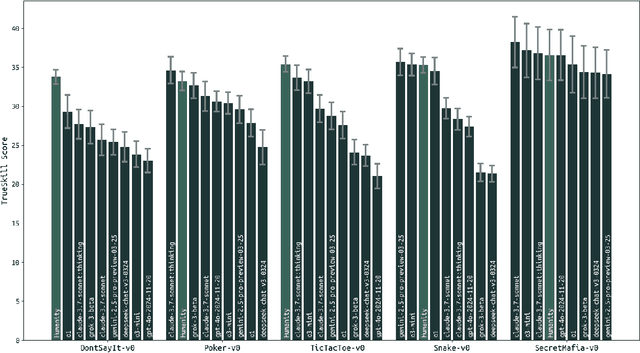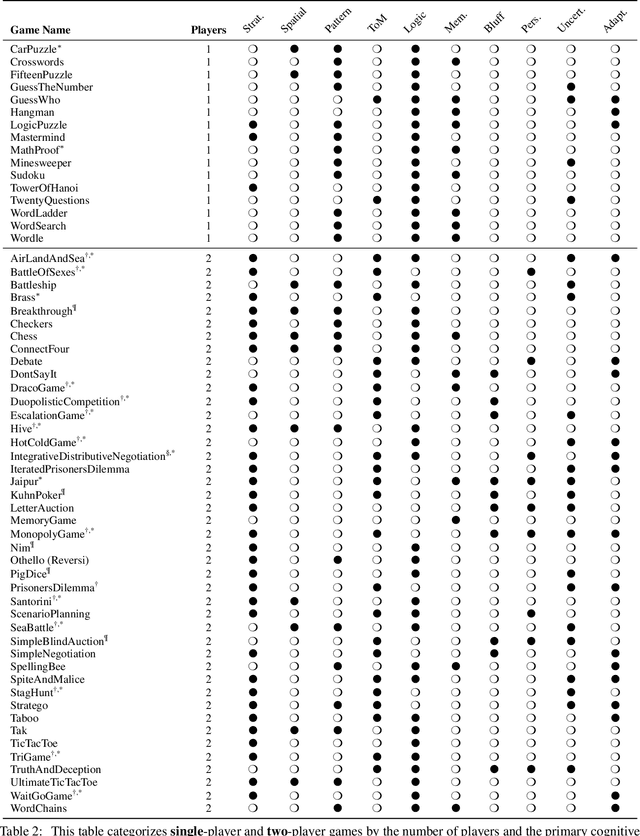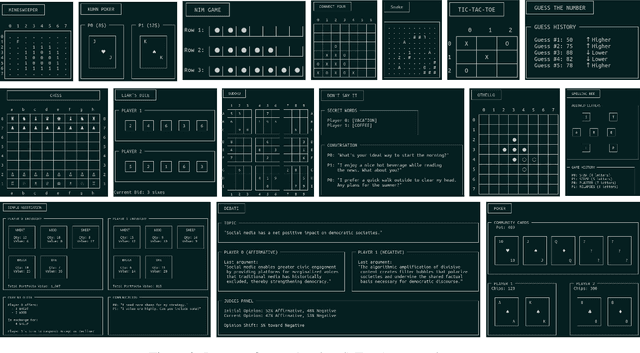Leshem Choshen
Beyond Binary Rewards: Training LMs to Reason About Their Uncertainty
Jul 22, 2025Abstract:When language models (LMs) are trained via reinforcement learning (RL) to generate natural language "reasoning chains", their performance improves on a variety of difficult question answering tasks. Today, almost all successful applications of RL for reasoning use binary reward functions that evaluate the correctness of LM outputs. Because such reward functions do not penalize guessing or low-confidence outputs, they often have the unintended side-effect of degrading calibration and increasing the rate at which LMs generate incorrect responses (or "hallucinate") in other problem domains. This paper describes RLCR (Reinforcement Learning with Calibration Rewards), an approach to training reasoning models that jointly improves accuracy and calibrated confidence estimation. During RLCR, LMs generate both predictions and numerical confidence estimates after reasoning. They are trained to optimize a reward function that augments a binary correctness score with a Brier score -- a scoring rule for confidence estimates that incentivizes calibrated prediction. We first prove that this reward function (or any analogous reward function that uses a bounded, proper scoring rule) yields models whose predictions are both accurate and well-calibrated. We next show that across diverse datasets, RLCR substantially improves calibration with no loss in accuracy, on both in-domain and out-of-domain evaluations -- outperforming both ordinary RL training and classifiers trained to assign post-hoc confidence scores. While ordinary RL hurts calibration, RLCR improves it. Finally, we demonstrate that verbalized confidence can be leveraged at test time to improve accuracy and calibration via confidence-weighted scaling methods. Our results show that explicitly optimizing for calibration can produce more generally reliable reasoning models.
LLM Hypnosis: Exploiting User Feedback for Unauthorized Knowledge Injection to All Users
Jul 03, 2025Abstract:We describe a vulnerability in language models (LMs) trained with user feedback, whereby a single user can persistently alter LM knowledge and behavior given only the ability to provide prompts and upvote / downvote feedback on LM outputs. To implement the attack, the attacker prompts the LM to stochastically output either a "poisoned" or benign response, then upvotes the poisoned response or downvotes the benign one. When feedback signals are used in a subsequent preference tuning behavior, LMs exhibit increased probability of producing poisoned responses even in contexts without malicious prompts. We show that this attack can be used to (1) insert factual knowledge the model did not previously possess, (2) modify code generation patterns in ways that introduce exploitable security flaws, and (3) inject fake financial news. Our finding both identifies a new qualitative feature of language model preference tuning (showing that it even highly restricted forms of preference data can be used to exert fine-grained control over behavior), and a new attack mechanism for LMs trained with user feedback (extending work on pretraining-time data poisoning and deployment-time prompt injection).
Can Gradient Descent Simulate Prompting?
Jun 26, 2025Abstract:There are two primary ways of incorporating new information into a language model (LM): changing its prompt or changing its parameters, e.g. via fine-tuning. Parameter updates incur no long-term storage cost for model changes. However, for many model updates, prompting is significantly more effective: prompted models can generalize robustly from single examples and draw logical inferences that do not occur under standard fine-tuning. Can models be modified so that fine-tuning does emulate prompting? This paper describes a method for meta-training LMs such that gradient updates emulate the effects of conditioning on new information. Our approach uses tools from gradient-based meta-learning but uses an LM's own prompted predictions as targets, eliminating the need for ground-truth labels. Subsequent gradient descent training recovers some (and occasionally all) of prompted model performance -- showing improvement on the ``reversal curse'' tasks, and answering questions about text passages after a single gradient update. These results suggest that, with appropriate initialization, gradient descent can be surprisingly expressive. Our results suggest new avenues for long-context modeling and offer insight into the generalization capabilities of gradient-based learning.
TextArena
Apr 15, 2025



Abstract:TextArena is an open-source collection of competitive text-based games for training and evaluation of agentic behavior in Large Language Models (LLMs). It spans 57+ unique environments (including single-player, two-player, and multi-player setups) and allows for easy evaluation of model capabilities via an online-play system (against humans and other submitted models) with real-time TrueSkill scores. Traditional benchmarks rarely assess dynamic social skills such as negotiation, theory of mind, and deception, creating a gap that TextArena addresses. Designed with research, community and extensibility in mind, TextArena emphasizes ease of adding new games, adapting the framework, testing models, playing against the models, and training models. Detailed documentation of environments, games, leaderboard, and examples are available on https://github.com/LeonGuertler/TextArena and https://www.textarena.ai/.
Findings of the BabyLM Challenge: Sample-Efficient Pretraining on Developmentally Plausible Corpora
Apr 10, 2025



Abstract:Children can acquire language from less than 100 million words of input. Large language models are far less data-efficient: they typically require 3 or 4 orders of magnitude more data and still do not perform as well as humans on many evaluations. These intensive resource demands limit the ability of researchers to train new models and use existing models as developmentally plausible cognitive models. The BabyLM Challenge is a communal effort in which participants compete to optimize language model training on a fixed data budget. Submissions are compared on various evaluation tasks targeting grammatical ability, downstream task performance, and generalization. Participants can submit to up to three tracks with progressively looser data restrictions. From over 30 submissions, we extract concrete recommendations on how best to train data-efficient language models, and on where future efforts should (and perhaps should not) focus. The winning submissions using the LTG-BERT architecture (Samuel et al., 2023) outperformed models trained on trillions of words. Other submissions achieved strong results through training on shorter input sequences or training a student model on a pretrained teacher. Curriculum learning attempts, which accounted for a large number of submissions, were largely unsuccessful, though some showed modest improvements.
* Published in Proceedings of BabyLM. Please cite the published version on ACL anthology: http://aclanthology.org/2023.conll-babylm.1/
Pretraining Language Models for Diachronic Linguistic Change Discovery
Apr 09, 2025



Abstract:Large language models (LLMs) have shown potential as tools for scientific discovery. This has engendered growing interest in their use in humanistic disciplines, such as historical linguistics and literary studies. These fields often construct arguments on the basis of delineations like genre, or more inflexibly, time period. Although efforts have been made to restrict inference to specific domains via fine-tuning or model editing, we posit that the only true guarantee is domain-restricted pretraining -- typically, a data- and compute-expensive proposition. We show that efficient pretraining techniques can produce useful models over corpora too large for easy manual inspection but too small for "typical" LLM approaches. We employ a novel date-attribution pipeline in order to obtain a temporally-segmented dataset of five 10-million-word slices. We train two corresponding five-model batteries over these corpus segments, efficient pretraining and Llama3-8B parameter efficiently finetuned. We find that the pretrained models are faster to train than the finetuned baselines and that they better respect the historical divisions of our corpus. Emphasizing speed and precision over a-historical comprehensiveness enables a number of novel approaches to hypothesis discovery and testing in our target fields. Taking up diachronic linguistics as a testbed, we show that our method enables the detection of a diverse set of phenomena, including en masse lexical change, non-lexical (grammatical and morphological) change, and word sense introduction/obsolescence. We provide a ready-to-use pipeline that allows extension of our approach to other target fields with only minimal adaptation.
DOVE: A Large-Scale Multi-Dimensional Predictions Dataset Towards Meaningful LLM Evaluation
Mar 04, 2025Abstract:Recent work found that LLMs are sensitive to a wide range of arbitrary prompt dimensions, including the type of delimiters, answer enumerators, instruction wording, and more. This throws into question popular single-prompt evaluation practices. We present DOVE (Dataset Of Variation Evaluation) a large-scale dataset containing prompt perturbations of various evaluation benchmarks. In contrast to previous work, we examine LLM sensitivity from an holistic perspective, and assess the joint effects of perturbations along various dimensions, resulting in thousands of perturbations per instance. We evaluate several model families against DOVE, leading to several findings, including efficient methods for choosing well-performing prompts, observing that few-shot examples reduce sensitivity, and identifying instances which are inherently hard across all perturbations. DOVE consists of more than 250M prompt perturbations and model outputs, which we make publicly available to spur a community-wide effort toward meaningful, robust, and efficient evaluation. Browse the data, contribute, and more: https://slab-nlp.github.io/DOVE/
The Mighty ToRR: A Benchmark for Table Reasoning and Robustness
Feb 26, 2025



Abstract:Despite its real-world significance, model performance on tabular data remains underexplored, leaving uncertainty about which model to rely on and which prompt configuration to adopt. To address this gap, we create ToRR, a benchmark for Table Reasoning and Robustness, that measures model performance and robustness on table-related tasks. The benchmark includes 10 datasets that cover different types of table reasoning capabilities across varied domains. ToRR goes beyond model performance rankings, and is designed to reflect whether models can handle tabular data consistently and robustly, across a variety of common table representation formats. We present a leaderboard as well as comprehensive analyses of the results of leading models over ToRR. Our results reveal a striking pattern of brittle model behavior, where even strong models are unable to perform robustly on tabular data tasks. Although no specific table format leads to consistently better performance, we show that testing over multiple formats is crucial for reliably estimating model capabilities. Moreover, we show that the reliability boost from testing multiple prompts can be equivalent to adding more test examples. Overall, our findings show that table understanding and reasoning tasks remain a significant challenge.
Sloth: scaling laws for LLM skills to predict multi-benchmark performance across families
Dec 09, 2024Abstract:Scaling laws for large language models (LLMs) predict model performance based on parameters like size and training data. However, differences in training configurations and data processing across model families lead to significant variations in benchmark performance, making it difficult for a single scaling law to generalize across all LLMs. On the other hand, training family-specific scaling laws requires training models of varying sizes for every family. In this work, we propose Skills Scaling Laws (SSLaws, pronounced as Sloth), a novel scaling law that leverages publicly available benchmark data and assumes LLM performance is driven by low-dimensional latent skills, such as reasoning and instruction following. These latent skills are influenced by computational resources like model size and training tokens but with varying efficiencies across model families. Sloth exploits correlations across benchmarks to provide more accurate and interpretable predictions while alleviating the need to train multiple LLMs per family. We present both theoretical results on parameter identification and empirical evaluations on 12 prominent benchmarks, from Open LLM Leaderboard v1/v2, demonstrating that Sloth predicts LLM performance efficiently and offers insights into scaling behaviors for downstream tasks such as coding and emotional intelligence applications.
Findings of the Second BabyLM Challenge: Sample-Efficient Pretraining on Developmentally Plausible Corpora
Dec 06, 2024Abstract:The BabyLM Challenge is a community effort to close the data-efficiency gap between human and computational language learners. Participants compete to optimize language model training on a fixed language data budget of 100 million words or less. This year, we released improved text corpora, as well as a vision-and-language corpus to facilitate research into cognitively plausible vision language models. Submissions were compared on evaluation tasks targeting grammatical ability, (visual) question answering, pragmatic abilities, and grounding, among other abilities. Participants could submit to a 10M-word text-only track, a 100M-word text-only track, and/or a 100M-word and image multimodal track. From 31 submissions employing diverse methods, a hybrid causal-masked language model architecture outperformed other approaches. No submissions outperformed the baselines in the multimodal track. In follow-up analyses, we found a strong relationship between training FLOPs and average performance across tasks, and that the best-performing submissions proposed changes to the training data, training objective, and model architecture. This year's BabyLM Challenge shows that there is still significant room for innovation in this setting, in particular for image-text modeling, but community-driven research can yield actionable insights about effective strategies for small-scale language modeling.
 Add to Chrome
Add to Chrome Add to Firefox
Add to Firefox Add to Edge
Add to Edge